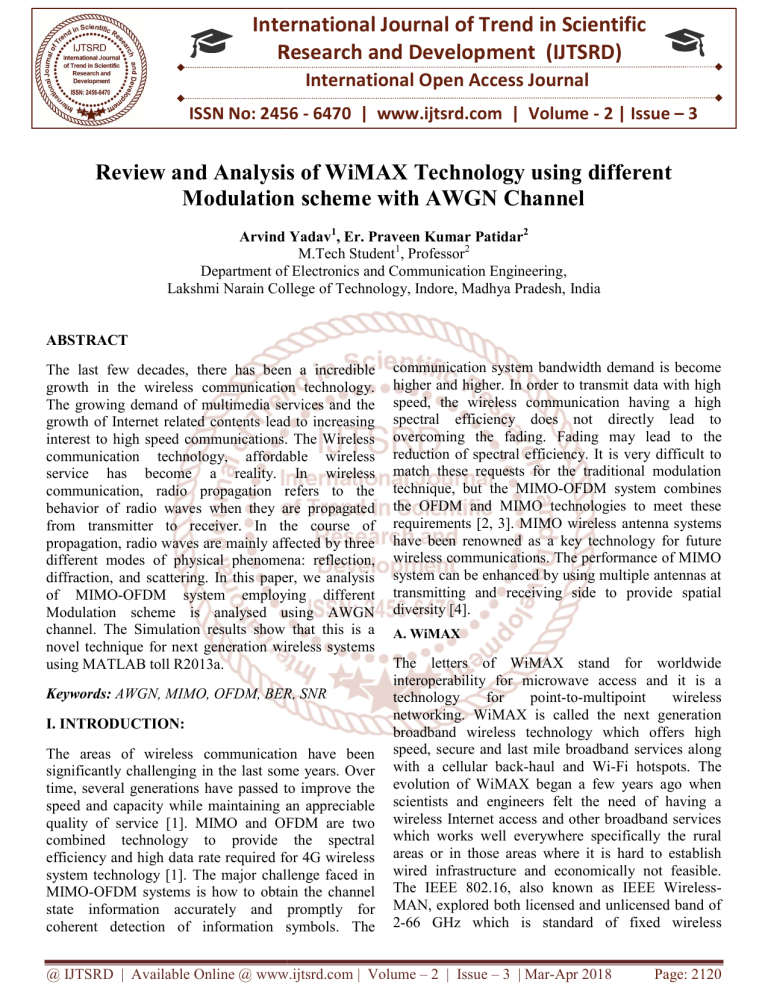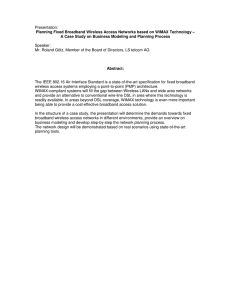
International Journal of Trend in Scientific
Research and Development (IJTSRD)
International Open Access Journal
ISSN No: 2456 - 6470 | www.ijtsrd.com | Volume - 2 | Issue – 3
Review and Analysis of W
WiMAX
iMAX Technology using different
Modulation scheme with AWGN Channel
Arvind Yadav1, Er. Praveen Kumar Patidar2
M.Tech Student1, Professor2
Department of Electronics and Communication Engineering
Engineering,
Lakshmi Narain Coll
College of Technology, Indore, Madhya Pradesh, India
ABSTRACT
The last few decades, there has been a incredible
growth in the wireless communication technology.
The growing demand of multimedia services and the
growth of Internet related contents lead to increasing
interest to high speed communications. The Wireless
communication technology, affordable w
wireless
service has become a reality. In wireless
communication, radio propagation refers to the
behavior of radio waves when they are propagated
from transmitter to receiver. In the course of
propagation, radio waves are mainly affected by three
different modes of physical phenomena: reflection,
diffraction, and scattering. In this paper, we analysis
of MIMO-OFDM
OFDM system employing different
Modulation scheme is analysed using AWGN
channel. The Simulation results show that this is a
novel technique for next generation wireless systems
using MATLAB toll R2013a.
Keywords: AWGN, MIMO, OFDM, BER, SNR
I. INTRODUCTION:
The areas of wireless communication have been
significantly challenging in the last some years. Over
time, several generations have passed to improve the
speed and capacity while maintaining an appreciable
quality of service [1]. MIMO and OFDM are two
combined
ined technology to provide the spectral
efficiency and high data rate required for 4G wireless
system technology [1]. The major challenge faced in
MIMO-OFDM
OFDM systems is how to obtain the channel
state information accurately and promptly for
coherent detection
on of information symbols. The
communication system bandwidth demand is become
higher and higher. In order to transmit data with high
speed, the wireless communication having a high
spectral efficiency does not directly lead to
overcoming the fading. Fading
ding may lead to the
reduction of spectral efficiency. It is very difficult to
match these requests for the traditional modulation
technique, but the MIMO-OFDM
OFDM system combines
the OFDM and MIMO technologies to meet these
requirements [2, 3]. MIMO wireless antenna systems
have been renowned as a key technology for future
wireless communications. The performance of MIMO
system can be enhanced by using multiple antennas at
transmitting and receiving side to provide spatial
diversity [4].
A. WiMAX
The letters off WiMAX stand for worldwide
interoperability for microwave access and it is a
technology
for
point-to
to-multipoint
wireless
networking. WiMAX is called the next generation
broadband wireless technology which offers high
speed, secure and last mile broadband services along
with a cellular back-haul
haul and Wi-Fi
Wi
hotspots. The
evolution of WiMAX began a few years ago when
scientists and engineers felt the need of having a
wireless Internet access and other broadband services
which works well everywhere specifically the rural
areas or in those areas where it is hard to establish
wired infrastructure and economically not feasible.
The IEEE 802.16, also known as IEEE WirelessWireless
MAN, explored both licensed and unlicensed band of
2-66
66 GHz which is standard of fixed wireless
wireles
@ IJTSRD | Available Online @ www.ijtsrd.com | Volume – 2 | Issue – 3 | Mar-Apr
Apr 2018
Page: 2120
International Journal of Trend in Scientific Research and Development (IJTSRD) ISSN: 2456-6470
broadband and included mobile broadband
application. WiMAX forum, a private organization
was formed in June 2001 to coordinate the
components and develop the equipment those will be
compatible and inter operable. After several years, in
2007, Mobile WiMAX equipment developed with the
standard IEEE 802.16e got the certification and they
announced to release the product in 2008, providing
mobility access. The IEEE 802.16e air interface based
on Orthogonal Frequency Division Multiple Access
(OFDMA) which main aim is to give better
performance in non-line-of-sight environments. The
mobile WiMAX Fig.1[5], is a technology based on
IEEE 802.16 standard [6] developed as a feasible and
attractive solution to these problems.
Fig. 1: WiMAX (IEEE 802.16) network architecture
II. MIMO- OFDM
A
multiple-input
multiple-output
(MIMO)
communication system combined with the orthogonal
frequency division multiplexing (OFDM) modulation
technique can achieve reliable high data rate
transmission over broadband wireless channels.
OFDM is techniques to digital encode data on the
multiple-frequencies. It is widely used in wireless
communication
networking,
Video,
audio
broadcasting, TV, wireless networks and 4G [7, 8].
OFDM plays a major role in both for wireless and
wired communications. It started in the 1870 when it
was used to carry the information via multiple
channels using a telegram [7, 8]. Among many
possible technologies for the secondary users’
transmission in the spectrum pooling systems, OFDM
has already been widely recognized as a particularly
novel candidate. This is mainly due to its great
flexibility in dynamically allocating the unused
spectrum among secondary users as well as its ability
to monitor the spectral activities of the licensed users
at no extra cost [11, 12, 13].
OFDM divides the high-rate stream into parallel
lower rate data and hence prolongs the symbol
duration, thus helping to eliminate Inter Symbol
Interference (ISI). It also allows the bandwidth of
subcarriers to overlap without Inter Carrier
Interference (ICI) as long as the modulated carriers
are orthogonal. OFDM therefore is considered as an
efficient modulation technique for broadband access
in a very dispersive environment. DAB (Digital Audio
Broadcasting), High Definition TV, Wireless LANs,
Mobile broadband [7].
IEEE 802.16: It operates in licensed spectrum of
2Ghz to11 Ghz.
IEEE 802.20: It operates below 3.5 GHz in the
licensed band.
Up to 155 miles/ h speed [7, 10].
@ IJTSRD | Available Online @ www.ijtsrd.com | Volume – 2 | Issue – 3 | Mar-Apr 2018
Page: 2121
International Journal of Trend in Scientific Research and Development (IJTSRD) ISSN: 2456-6470
After inserting pilots either to all subcarriers with a specific period of blocks or within a uniform period of
frequency bins in all blocks, IDFT block is used to transform the data sequence of length into time domain
signal with the following equation 1.
Fig. 2: SISO OFDM System Block Diagram
Fig. 3: MIMO OFDM System Block Diagram
Spatial multiplexing Gain: the transmission of multiple data streams over more than one antenna is called
spatial multiplexing. The advantage of spatial multiplexing is linear capacity gains in relation to the number of
transmit antennas. This gain, referred to as spatial multiplexing gain, is realized by transmitting independent
data signals from the individual antennas [14]. Spatial diversity gain: spatial diversity improves the signal
quality and achieves a higher signal to noise ratio at the receiver side. Signal power in a wireless channel
fluctuates randomly or fades. Diversity is a powerful technique to mitigate fading in wireless links. Consider a
space time block coded MIMO-OFDM system [15] equipped with transmit antennas and receive antennas as
illustrated in Figure 4.
@ IJTSRD | Available Online @ www.ijtsrd.com | Volume – 2 | Issue – 3 | Mar-Apr 2018
Page: 2122
International Journal of Trend in Scientific Research and Development (IJTSRD) ISSN: 2456-6470
Fig. 4: Block Diagram of Space Time Block Coded MIMO-OFDM system Structure[9]
III. MODULATION
Table 1: Performance of IEEE 802.16e Parameters
Modulation is the process of facilitating the transfer
of information over a medium. Sound transmission in
air has limited range for the amount of power your
lungs can generate. To extend the range your voice
reach, we need to transmit it through a medium other
than air, such as a phone line or radio. The process of
converting information (voice in the case) so that it
can be successfully sent through a medium (wire or
radio waves) is called modulation.
Parameters
Communication Channel
Modulation Techniques
IV. CHANNEL ESTIMATION
When a signal containing audio or video is
transmitted through the air medium or wireless
medium to the receiver (Rx), some of its
characteristics are changed due to present noise and
interference in the atmosphere[9]. This distorted
signal is unable to provide useful information; some
of these characteristics are change like frequency,
amplitude and Phase. A wideband radio channel is
normally time variant and Frequency selective. For an
OFDM communication system, the channel
transferred at different subcarriers appears in the
receiver with unequal frequency and time domains.
Therefore, dynamic estimation of the signal is
necessary [7, 9].
IFFT (Input port size)
CC Code Rate
Radio Technology
Used Scheme
System (Single and
Multiple)
Model
Calculation Parameters
Simulation-Used
Tool/Software
Value
AWGN
2-PSK, 4-PSK, 8-QAM
and 16-QAM
256
½
OFDM
Alamouti
MIMO
WiMAX 802.16e
BER V/s SNR
Matlab (R2013a)
V. PERFORMANCE ANALYSIS
To analyze the performance of WiMAX (OFDMsystems) based on the different simulation parameters
consider and obtain simulation results. We
investigated the BER V/s SNR plot by using AWGN
channel. The performance of WiMAX model analysis
on used the following parameters as shown in table 1
Fig. 5: Performance Analysis of 2*4 MIMO
systems using different modulation with AWGN
Channel
@ IJTSRD | Available Online @ www.ijtsrd.com | Volume – 2 | Issue – 3 | Mar-Apr 2018
Page: 2123
International Journal of Trend in Scientific Research and Development (IJTSRD) ISSN: 2456-6470
VI. CONCLUSION
The WiMAX technology is a broadband wireless data
communications technology based around the IEEE
802.16 standard providing high speed data over a
wide area. In this performance result is shown in
figure 5, we have used the Alamouti scheme with
communication AWGN channel and different
modulation techniques. The performance is displayed
in terms of the BER verses SNR logarithmic plot.
We analysis the 16-QAM, SNR is increased 6.1dB on
BER at as compared to 8-QAM and Modulation
Techniques at a constant signal power.
REFERENCES
1) Asma Bouhlel, Anis Sakly and Nejib Mansouri
“Performance comparison of DFT based MIMO
OFDM and FET based MIMO-OFDM” AWICT2015, Elsevier, Procedia Computer Science 73 (2015)
266-273.
2) Ammar Ali Sahrab “MIMO-OFDM: Maximum
Diversity Using Maximum Likelihood Detector”
2014 IEEE.
3) Jiang Xuehua, and Chen Peijiang, “Study and
Implementation of MIMOOFDM System Based
on Matlab,” IEEE Computer Society: International
Conference on Information Technology and
Computer Science, pp. 554–557, 2009.
4) M.Raju “Mean Square Error Analysis in MIMOOFDM System using Pilot based Channel
Estimation” 2016 IEEE, (SCOPES-2016).
5) Federal “A Mobile WiMAX Mesh Network with
Routing Techniques and Quality of Service
Mechanisms” Selected Topics in WiMAX,
Chapter 3, INTECH 2013.
6) IEEE 802.16e-2005 Part 16: Air Interface for
Fixed and Mobile Broadband Wireless Access
Systems Amendment 2: Physical and Medium
Access Control Layers for Combined Fixed and
Mobile Operation in Licensed Bands, 2005
8) Kala Praveen Bagadi “MIMO-OFDM Channel
Estimation using Pilot Carries” International
Journal of Computer Applications (0975 – 8887)
Volume 2 – No.3, May 2010.
9) Chang-Yi Yang, Yu-Li Chen, Hai-Yan Song
“Adaptive Carrier Frequency Offset and Channel
Estimation for MIMO-OFDM Systems” 2016
IEEE DOI 10.1109/WAINA.2016.68.
10) While Zhang, Feifei Gao, and Qinye Yin “Blind
Channel Estimation for MIMO-OFDM Systems
with Low-Order Signal Constellation” IEEE
Communications Letters, Vol. 19(3), March 2015.
11) Hamid Shahrokh Shahraki, Kamal MohamedPour “Efficient Power Loading in MIMO-OFDM
Based Cognitive Radio Networks” Scientific
Research, Communications and Network, 2011, 3,
8-16.
12) R. V. Nee and R. Prasad, “OFDM for Wireless
Multimedia Communication,” Artech House,
London, 2000.
13) U. Berthold, F. Jondral, S. Brandes and M.
Schnell, “OFDM-Based Overlay Systems: A
Promising Approach for Enhancing Spectral
Efficiency [Topics in Radio Communications],”
IEEE Communications Magazine, Vol. 45(12),
December 2007, pp. 52-58.
14) Kala Praveen Bagadi and Susmita Das “MIMOOFDM Channel Estimation using Pilot Carries”
International Journal of Computer Applications
(0975 – 8887) Vol. 2 (3), May 2010.
15) Md. Mejbaul Haque, Mohammad Shaifur Rahman
and Ki-Doo Kim “Performance Analysis of
MIMO-OFDM for 4G Wireless Systems under
Rayleigh Fading Channel” International Journal of
Multimedia and Ubiquitous Engineering Vol.
8(1), January, 2013.
16) Y. Chang, R. Zhang “Transmit Optimization
for MIMO-OFDM With Delay-Constrained and
No-Delay-Constrained Traffic”, IEEE Transaction
on signal processing, Vol. 54(8), 2006.
7) Ramanpreet Kaur, Harjinder Singh “A Review
Paper on Performance Analysis of Channel
Estimation in MIMO-OFDM System” IJSRD International Journal for Scientific Research &
Development| Vol. 5, Issue 06, 2017 | ISSN (online):
2321 - 061.
@ IJTSRD | Available Online @ www.ijtsrd.com | Volume – 2 | Issue – 3 | Mar-Apr 2018
Page: 2124



